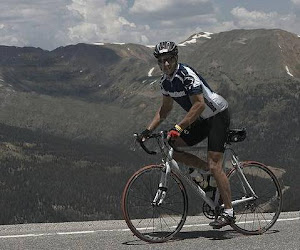Also, what if you have 3 or more bikes like I do? Should they all be fitted the same and have the same seat height? Well, that depends. Generally, Mountain bike seats are a little lower than road bike seats because of the constant stop and go when trail riding. But, what if you just ride your mountain bike on dirt or chip seal roads like you would a road bike? In that case, you'll want to make sure your seat height is the same as your road bike. What about a Time Trial Bike? Most of those bikes put you in a more forward position for optimum aerodynamics. How about an indoor trainer bike? Should that seat height be the same as your road bike that you ride outdoors? I think so.
What's the best way to ensure your seat height is at the correct position? I think the simplest/quickest and best way is to place your pedals at the 6 and 12 o'clock position. Actually, the bottom pedal should be more inline with the seat tube which will make the bottom position more of a 5 or 7 o'clock position (depending on which side of the bike you're looking) rather than 6 o'clock. Now, sit on the bike (with your riding shoes on) and place the heel of your foot in the middle of the bottom pedal. When your leg is fully extended (and your hips are level over the seat), that is the seat height you want to measure and record. (A good place to do the seat height measurement/check is with your bike attached to an indoor trainer so you can ensure the bike is upright and level.) The 'official' seat height is the distance from the middle of the bottom bracket (where the pedal crank is attached) to the top/middle of the seat. (See figure below). I would measure with both legs because I've found as much as 1 inch of leg length discrepancies with some athletes. What do you do if that's the case? Well, I'm not a fan of shimming the shorter leg/shoe because the body has a way of compensating for this discrepancy. Shimming a shoe might create problems that never existed before. If it's an inch discrepancy, I'd split the difference. Save the seat height measurement for future reference. What I like to do is place some electrical tape at the bottom of my seat post, where it's inserted and clamped to the top of the seat tube. That way, I can tell if my seat loosens and drops throughout the riding season. If you have an all composite bike frame, be sure you have the correct torque value for tightening your seat post. You don't want to crack the frame from over-tightening.
What if you have 3-4 different bikes? I'd set them up the same. i.e. same height. That is, the seat heights would be pretty close across all 3. The only bike I'd adjust up/down would be my mountain bike. If I'm riding the trails, I want the seat a little lower in case I have to clip out or step out quickly. If I'm riding the mountain bike on a gravel road or dirt road, I want the seat height raised the same as my road bike. That's why just about all mountain bikes have a quick adjust bolt to raise and lower the seat.
A correct seat height will allow you to ride longer and push harder generating more power..and more importantly it will prevent any pain in your legs or injury.
Power ON! Coach Rob






No comments:
Post a Comment